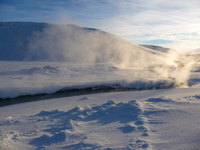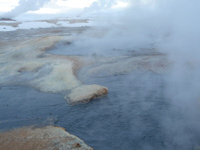Iceland: Land of fire and ice
A day or two's drive from the much-visited Reykjavík, north Iceland's beautiful Mývatn area epitomises this volatile land of contrasts, especially in winter. Words and photos by Caroline Bishop.
I pulled myself out of the water and sat on a rock on the edge of the pool. The night air was well below freezing, I was wearing a bikini and yet I was too hot.
We were taking an evening dip in the Mývatn Nature Baths, north Iceland's answer to Reykjavík's more famous Blue Lagoon. This geothermal water is drawn from a bore hole which burrows 2,500m (8,202ft) into Iceland's tempestuous ground. It bubbles to the surface at around 130˚C (266˚F) so it's cooled to 36-40˚C (97˚F-104˚F) to provide a naturally heated outdoor swimming bath.
There were few bathers on this dark winter night. We sat on the rocks, skin slippery with the mineral-rich water and glowing orange in the low lights, watching the steam make lazy curls into the darkness. Where in most natural lakes you'll encounter cold patches, here we swam through pockets of almost uncomfortable heat. After just half an hour it was too hot to bear, and we dragged ourselves out into Iceland's frigid night air, a heat-induced lethargy turning our legs to jelly.
Ice and fire
Such stark contrasts are what makes Iceland so fascinating to visit in winter. I'd driven with my boyfriend Matt to Mývatn from Reykjavík, taking Route 1 - Iceland's main highway, which circles the country - around the south and east. We'd experienced gloriously erratic weather: high winds which buffeted our car across the tarmac, already slippery with ice; then heavy rain; then a white-out which had us crawling along, squinting for the next road marker. But suddenly the clouds would part, offering a sunlit glimpse of the coastal rock formations at Vík, or the eastern fjords, looming out of the mist.
 Thermal river
Thermal riverOur arrival in Mývatn was delayed by a blizzard that cut off the road; but the next morning was clear and bright, pink clouds and a low sun shepherding us through a plush duvet of snow. As we approached, we saw plumes of steam fizzing up from the frozen ground, a thermal river scorching a path through snow, and the distinct outline of volcanic craters, their flanks streaked with white. No wonder the film crew for fantasy series Game of Thrones were in Mývatn scouting for locations.
Lava, trolls and midges
Sitting on the precarious join between the North American and Eurasian tectonic plates (which are growing apart an inch a year), Mývatn's otherworldly landscape has been shaped by high volcanic activity. A designated nature reserve, in summer it's Icelanders' favourite playground: they come to hike, horse ride and camp, or bird-spot around Lake Mývatn, the centrepiece of the area and a twitcher's idyll.
Unfortunately, the water attracts midges as well as birds (mývatn means 'midge'), but in winter the bugs - and most of the tourists - flee the cold, leaving it to the locals and the few visitors willing to explore in the snow and the glorious soft light of a northern winter.
 Hverir's mud pools
Hverir's mud pools We certainly were. First up was a walk around the Dimmuborgir lava formations, thought to be the product of a massive volcanic eruption 2,300 years ago. The resultant dark brown, craggy sculptures protrude from the ground like chocolate cornflake cakes. On our visit they were embedded in fresh snow so thick it obscured the many walking trails around them. Without snowshoes, we were up to our knees in it as we admired nature's handiwork.
According to local myth, the formations are home to the Yule Lads, trolls with catchy names such as Door Slammer and (my favourite) Sausage Swiper. Icelanders are rather obsessed with elves and trolls, we discovered, but with landscape this unusual it's not surprising they believe magical forces lurk within it.
The power of earth
The mud pools of Hverir, to the north-east of the lake, hiss and bubble like a troll's cauldron. The frozen ground is thawed by hot mud as 200˚C (392˚F) steam is ejaculated from the earth's belly in noisy plumes. The mud is like orange-brown diarrhoea, and it smells like it too. In fact most places in Iceland smell bad, thanks to the sulphuric water which leaves a whiffy residue on your skin and hair after a shower.
This smelly steam is important to Iceland, however. Over the hill near the dangerous Krafla volcano is a power station which harnesses this geothermal energy for electricity and heat. In fact, the majority of Iceland's energy comes from renewable sources, both geothermal and - from the country's waterfalls, glaciers and rivers - hydroelectric.
 Hverfjall volcano
Hverfjall volcanoLess active but equally impressive is the volcano crater Hverfjall. At just 452m (1,482ft), it's easy to climb, even in snow; your reward at the top is one of the largest tephra (volcanic rock fragments) rings in the world. We hiked up with glee, childishly delighted to be walking on a volcano and revelling in the stunning view over the lake and the fantasy-world landscape below. It's possible to walk all around the crater rim, but not long after we reached the top the cloud came in and the other side of the vast bowl rapidly disappeared. Reluctantly we descended, laughing as we took the quickest method - sledging on our salopette-clad bums down the snowy slope.
Light show
That evening, back in our wood cabin at the Dimmuborgir Guesthouse on the eastern shore of Lake Mývatn, Matt popped out. Five seconds later, he yelled: "Get out here now!". Pulling on my coat, I dashed out into the cold to see a scarf of shimmering green hanging in the dark sky. We'd been waiting for her all trip and now she was here: the aurora borealis.
At 66 degrees north and with minimal light pollution, Mývatn is better placed than the capital to display nature's light show. We hugged each other in delight as we watched the emerald glow alternately fade and brighten over Hverfjall. Half an hour later, the capricious lady vanished, but she'd made our trip to this revelatory country complete.
Insider tips
It's worth hiring a four-wheel drive in winter, even if you're sticking to Route 1, and keep a spade in the boot to dig yourself out of the snow. View road conditions (http://www.vegagerdin.is/english/road-conditions-and-weather) before you set off, and if in doubt, ask a local.
Accommodation is often cheaper during the off peak winter. Prices at Dimmuborgir Guesthouse (www.dimmuborgir.is) start from around £100 per cabin per night (sleeping four maximum).
Food is delicious and hearty - try local specialities arctic char, Geysir bread (baked in the ground) and skyr (an Icelandic yoghurt) at the Cowshed Cafe (www.vogafjos.net), where the farm's dairy cows hang out in the next room. Wine and spirits are expensive.
Look for the Northern Lights on a clear, dark night from October-March. The aurora forecast (http://en.vedur.is/weather/forecasts/aurora/) should give you a heads-up.
Fly to Reykjavik with Iceland Air for around £250 return per person (in November). Entry to the Nature Baths (www.jardbodin.is ) costs £14 from Sept-May.
Do you have any Feedback about this page?
© 2025 Columbus Travel Media Ltd. All rights reserved. No part of this site may be reproduced without our written permission, click here for information on Columbus Content Solutions.









 You know where
You know where